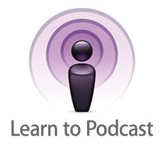 Gary Shelly describes a podcast as "a series of audio or video files that are broadcast to a computer or personal media player over the Internet." Users can subscribe to a podcast series by using a podcast reader application. Apple's iTunes is a popular podcast reader application that allows you to download and manage your podcast subscriptions.
Gary Shelly describes a podcast as "a series of audio or video files that are broadcast to a computer or personal media player over the Internet." Users can subscribe to a podcast series by using a podcast reader application. Apple's iTunes is a popular podcast reader application that allows you to download and manage your podcast subscriptions.Podcasting became popular at the same time that personal media players such as Apple's iPod were becoming the preferred portable device for listening to music. Although the term podcast was inspired by the popularity of the iPod, podcast sometimes is defined as an acronym for "Personal On Demand broadcast."
Podcasting has changed the way that many people think about multimedia. Podcasts provide content to watch whenever you want and wherever you are. Tools for creating and publishing content are readily available.
You can subscribe to podcasts through online Web sites as well as the Apple iTunes Store. Subscribing to podcasts is almost always free. Politicians have used podcasts to communicate with voters. College teachers create podcasts of lectures so that students can download and listen to them again later. (Web 2.0 Concepts and Applications, Shelly/Frydenberg)
Creating podcasts requires basic equipment for recording and editing digital audio and video. So, let's get started by watching a short video illustrating how to use GarageBand to create a podcast!
Activity #1 - Create a audio podcast using GarageBand. (Future Activity: Create a video podcast using GarageBand and/or iMovie.) You will be provided with Project Steps for "Creating a Podcast" and a copy of AHS announcements to use for your podcast.
If you don't like to sound of your voice, try out the Text2Speech website! This web tool is a simple online application which converts a block of typed text into a mp3 sound file. All you need to do is type or cut and paste text into the provided text block and click "covert text to speech".
Activity #2 - Configure Blogger to support podcasts and post an episode of a podcast to your blog. To configure your blog to generate a podcast feed, you need to configure the settings to add the enclosure information based on the video content that you specify. Setting the "Show Link Fields" option located on the Formatting page of the Setting tab, to "Yes" generates enclosure tags for blog posts with multimedia. The next step is to write a new blog post that will contain the heading for your podcast episode along with its video file. When you upload your video to Blogger, Blogger will convert it into two different formats: an MP4 version for the podcast feed and a Flash version to display in the blog post. After you publish the post, the video will be embedded on your blog.




